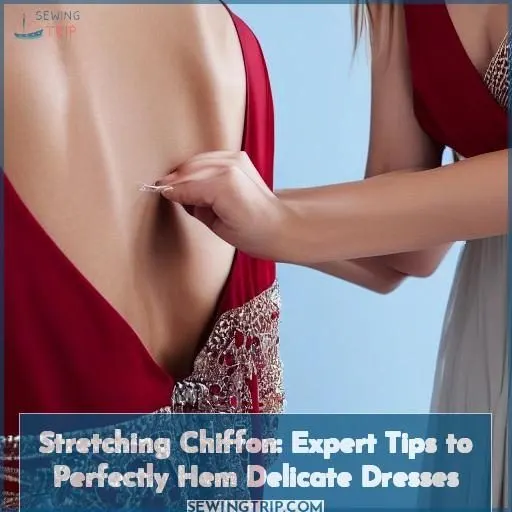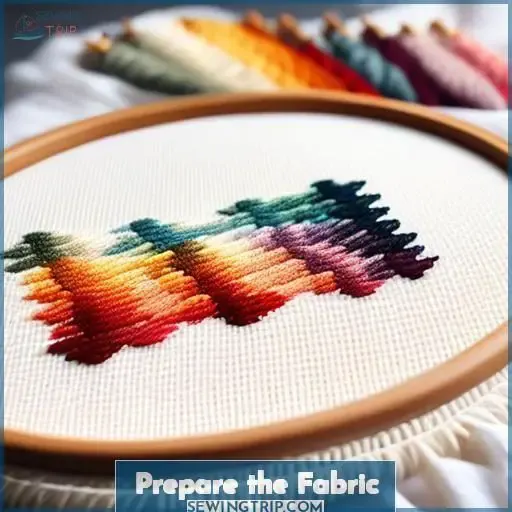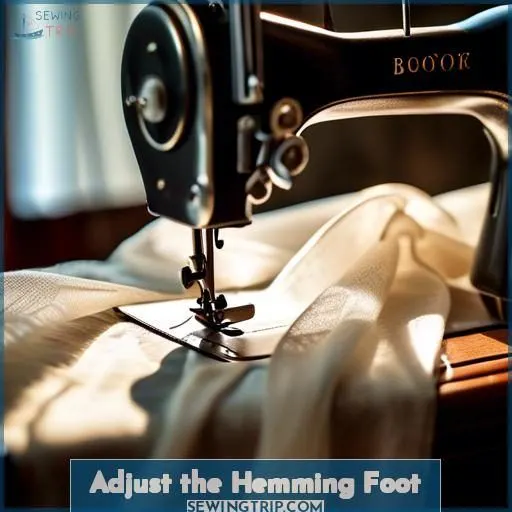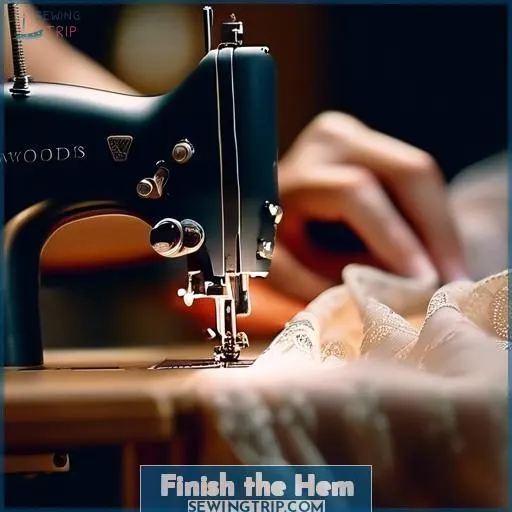This site is supported by our readers. We may earn a commission, at no cost to you, if you purchase through links.
To stretch and hem a chiffon dress, first prepare the fabric by folding in the raw edge and pressing it with an iron. Use a small, sharp needle to pick up single threads along the fold, positioning the stitches close to the fold and applying firm pressure without pulling the fabric too tight.
Next, choose the ideal hemming technique, such as a straight stitch with a 1/4 inch rolled hem or a serged rolled hem. Use a stretch thread or regular polyester serger thread, adjusting the needle, tension, and stitch length as needed.
With the right approach, you can create a beautifully hemmed, stretchy chiffon dress.
Table Of Contents
Key Takeaways
- Fold in the raw edge of the chiffon fabric and press it using an iron set to the appropriate temperature for the fabric.
- Use a small, sharp needle for hand sewing the hem, picking up single threads along the hem and positioning the stitch close to the fold without pulling too tight.
- Choose the right hemming technique, such as a straight stitch with a 1/4 inch rolled hem or a serged rolled hem, and use a stretch thread or regular polyester serger thread, adjusting the needle, tension, and stitch length as needed.
- Monitor the fabric tension carefully, as excessive pulling may result in puckering or ruffling of the hem.
How to Stretch a Chiffon Dress?
To stretch a chiffon dress, you can follow these steps:
- Mark the amount you want to take off with silk thread, ensuring you can mark the exact amount needed.
- If the dress is delicate, consider hand hemming using a hand roll seam, as it maintains the lightweight quality of chiffon better than machine sewing.
- Iron the fabric flat to give it a crisp edge, using the polyester setting on your iron if the chiffon is 100% polyester.
- Remove the basted line along the fold line.
Remember to take your time and be patient when working with chiffon, as it can be tricky to handle and may require careful handling to avoid stretching or damaging the fabric.
Prepare the Fabric
Start by folding in the raw edge and pressing the fold in place with an iron. Use a small, sharp needle to carefully pick up single threads along the hem, positioning the stitches close to the fold without pulling too tight.
Fold in the Raw Edge
To prepare the fabric for hemming, start by folding in the raw edge. This will create a clean and even hemline. Then, press the fold in place using an iron, ensuring that the ironed pleat is smooth and flat.
Next, use a small, sharp needle for hand sewing, picking up single threads along the hem. Position the stitch close to the fold and apply firm pressure, but avoid pulling too tight.
For stretch fabrics like chiffon, consider using a serged rolled hem, fishline hems, or the banroll method. Always match the needle and thread well, and adjust the hemmer foot if necessary.
Press the Fold in Place Using an Iron
To prepare the fabric for hemming, follow these steps:
- Fold in the raw edge of the chiffon fabric, ensuring that the fold is even and accurate.
- Press the fold in place using an iron set to the appropriate temperature for the fabric. For chiffon, a low to medium heat is recommended to avoid damaging the delicate fibers.
- Use a small, sharp needle for hand sewing the hem, as this will provide better control and precision.
- Pick up single threads along the hem, ensuring that they’re evenly distributed and not pulled too tight.
- Position the stitch close to the fold, using firm pressure but not pulling the fabric too tight.
- Use a new needle for hand sewing to prevent skipped stitches.
Use a Small, Sharp Needle for Hand Sewing
After pressing your fold with an iron, it’s time to delve into the intricacies of hand sewing. Here’s how to make those tiny stitches shine:
- Choose a small, sharp needle to effortlessly pick up single threads without a hitch.
- Apply firm pressure but keep it gentle to avoid puckering near the close fold.
- Hand baste if you’re aiming for precision, especially when using a metal hemmer or tackling tricky fishline hems. Remember, the smallest rolled hem foot and the right rolled hem setting are your best friends in achieving that flawless finish.
Pick Up Single Threads Along the Hem
To hem chiffon, pick up single threads along the hem while hand sewing. Utilize a diminutive, sharp needle and a firm but not constricted grip. This tactic guarantees that the stitch is proximate to the fold, precluding omitted stitches and upholding the fabric’s delicate nature. Recall, a 1/4 rolled hem with stretch thread is propitious for chiffon.
Position the Stitch Close to the Fold
To make sure a hem is perfect, adjust the stitch position to be close to the fold. Use a sharp needle and adjust the thread tension for the hand-sewing technique. For stretch chiffon, a straight stitch or chain stitch may be more suitable. Remember to keep the fabric tension and apply firm pressure without pulling too tight.
Use Firm Pressure but Do Not Pull Tight
To perfectly hem chiffon, apply firm pressure but avoid excessive tension. This will help keep the stitch spacing uniform and the needle size compatible with the thread elasticity. Monitor the fabric tension carefully, as excessive pulling may result in puckering or ruffling of the hem. Note that incorrect orders resulting from color discrepancies aren’t eligible for returns.
Choose the Right Hemming Technique
Struggling to hem your delicate chiffon dress? The right hemming technique can make all the difference. From a classic straight stitch with a 1/4 inch rolled hem to a serged rolled hem, there are several options to perfectly finish your garment’s edge.
Straight Stitch With 1/4 Rolled Hem
When hemming your bridesmaids or formal dress, a straight stitch with a 1/4 rolled hem offers a clean finish. Make sure thread tension is balanced—too tight and you’ll have puckering, too loose and you risk loose stitches. Matching fabric and thread is key; consider tacking hems before final stitching and always press folds for precision.
- Freedom in Fabric: No more fear of fraying; your hem is secure.
- Mastery of the Material: Conquer chiffon with a perfectly pressed hem.
- Gift of Perfection: Whether it’s a gift return or your own, the return policy has your back.
Serged Rolled Hem
Serging a rolled hem is a popular technique for hemming delicate fabrics like chiffon, lace, and silk. This method involves using a serger to create a narrow hem that’s perfect for hemming lightweight or delicate fabrics. To prepare the fabric for a serged rolled hem, you should follow these steps:
- Fold the fabric under to create a hem, ensuring that the raw edge is fully covered by the stitching.
- Adjust the overlock settings on your serger to accommodate the fabric type and desired look. For stretch fabrics, you may need to adjust the thread tension, needle size, and stitch length to ensure a smooth finish.
- Choose the appropriate thread for your project. Regular polyester serger thread or woolly nylon thread in the loopers can be used, depending on the fabric and desired finish.
- Position the fabric correctly in the serger foot, ensuring that the raw edge is aligned with the needle.
- Sew the rolled hem, using a short, dense overlock stitch to cover the edge of the fabric.
When using a serger for a rolled hem, it’s essential to use the correct settings and thread to achieve the desired look. You may need to adjust the tension settings, stitch length, and needle size to accommodate the fabric type and desired finish. Additionally, using a narrow stitch finger can help create a perfect roll for the hem.
Serged rolled hems are commonly used for evening party dresses, homecoming dresses, and wedding guest dresses, as they provide a professional-looking finish that can withstand the rigors of laundering. If you encounter any issues with the hem, such as skipped stitches or uneven coverage, you may need to adjust the needle or replace it with a new one.
1/4 Inch Hemmer Attached to Overlocker With Chain Stitch
To create a 1/4 inch hemmer attached to an overlocker with a chain stitch, you’ll need to think about fabric tension, needle size, and thread weight.
Start by setting the seam finish on your overlocker to the desired stitch length and width. This will guarantee a consistent hem and prevent any problems with fabric feed.
The chain stitch is a common choice for stretch fabrics, but you may want to try different thread weights and needle sizes to find the best combination for your project.
Hand Basting and Sewing Over
Hand basting is a technique used in sewing to temporarily hold fabric layers together before the final stitching. It involves using a needle and thread to create a series of loose stitches that can be easily removed once no longer needed. Here are some tips for hand basting:
- Thread the needle: Use a long piece of cotton thread in a contrasting color for visibility.
- Align the fabrics: Make sure the fabrics are nicely aligned together. Use pins or sewing clips if necessary.
- Start basting: Begin by taking a couple of small, evenly spaced stitches through all layers of fabric.
- Make the stitches bigger: Keep them about a quarter inch apart and don’t pull them too tightly. Basting stitches can be a bit messy, but they’ll be removed or hidden in the seam.
- Remove pins: Once you’ve basted the entire area, remove any pins you might’ve used and check that the fabric is still aligned correctly.
- Sew the fabrics together: Sew the fabrics together on your sewing machine with the permanent stitches.
- Pull out the basting stitches: Once you have sewn the fabrics permanently, pull out the basting stitches. This should be fairly easy if you didn’t sew over them.
Hand basting is often used when more control and stability is needed, such as when stitching very curved edges or working with thin, flimsy, and sheer fabrics. It’s also a quick and effective form of basting that can be easily removed once no longer needed.
Select the Appropriate Thread
When hemming delicate chiffon fabrics, you’ll want to choose stretch thread like Eloflex or similar for the best flexibility. Regular polyester serger thread or metallic thread in the loopers can also work adequately, but ensure to carefully match your needle and thread for the most effective results.
Stretch Thread (Eloflex or Similar)
Elastic thread, such as Eloflex or its equivalents, is a vital component when handling delicate fabrics like chiffon. To achieve optimal results, consider the following pointers:
- Thread quality: Select premium elastic thread that can withstand the tension and elasticity needed for hemming delicate fabrics.
- Thread tension: Adjust the thread tension to maintain a consistent stitch length and prevent the thread from snapping or stretching excessively.
- Stitch length: Choose a slightly longer stitch length to accommodate the fabric’s elasticity.
- Seam finish: A straight stitch with a 1/4 rolled hem is a popular choice for chiffon, as it provides a clean and tidy finish while allowing the fabric to maintain its natural drape.
Regular Polyester Serger Thread or Metallic Thread in Loopers
Regarding the hemming of delicate chiffon dresses, the thread selection is essential. For a more conventional appearance, choose standard polyester serger thread. If you desire a touch of sparkle, metallic thread in the loopers can elevate the curl. Note that the needle and thread should be appropriately paired to guarantee a seamless sewing experience.
Match the Needle and Thread Well
To guarantee a flawless hem, it’s critical to pair the needle and thread appropriately. Here are three essential considerations:
- Needle Size: Select a needle size that corresponds to the fabric and thread type. A smaller needle is often preferred for delicate fabrics like chiffon.
- Thread Type: Utilize a thread that complements the fabric’s elasticity and texture. For chiffon, elastic threads like Eloflex are optimal.
- Tension Balance, Stitch Length, and Seam Allowance: Modify these factors to achieve a well-balanced, even stitch. A longer stitch length may be required for stretchy fabrics. Bear in mind that a well-matched needle and thread can significantly impact the aesthetics and durability of your hem.
Adjust the Hemming Foot
When hemming delicate chiffon fabrics, the smallest rolled hem foot may be your best bet. Make sure to use a new needle to prevent skipped stitches and guarantee a smooth, professional-looking finish.
Smallest Rolled Hem Foot May Be Successful
The smallest rolled hem foot may be the key to successfully hemming your stretch chiffon fabric. Adjust the foot size to accommodate the fabric’s stretching, ensuring a consistent stitch density. Use a needle size appropriate for the thread tension and fabric type. Remember, the right adjustments can make all the difference in achieving a flawless hem.
New Needle Required to Prevent Skipped Stitches
To prevent skipped stitches and guarantee a smooth hem, you need a sharp needle. A blunt needle can cause the thread to break or skip stitches, leading to an uneven hem.
Adjust the needle tension and fabric preparation. Position the stitch close to the fold, and use firm pressure without pulling too tight. This will help maintain the hem’s shape and prevent any stretching or ruffling.
Finish the Hem
If you need to make a return, be sure to contact customer service to get an RMA number first. Keep in mind that a 20% restocking fee applies, and the item must be in unused, original condition with original packaging.
Initiate Return by Contacting Customer Service for RMA Number
To initiate a return, you should contact customer service and request a Return Merchandise Authorization (RMA) number. This unique identifier will help track the return process and guarantee that your request is handled efficiently.
Once you have the RMA number, you should follow the instructions provided by the customer service representative to package and ship the item back to the specified return address. It’s crucial to include the RMA number and a packing list copy with the return to ensure a smooth and accurate processing of your return.
Include RMA Number and Packing List Copy With Return
When you’re prepared to return that dress, be sure to attach a duplicate of the RMA number and the packing list with your return. This is your passport to sidestepping any snags with restocking fee refunds.
Guarantee everything’s in pristine, original condition and nestled securely in its original packaging. It’s akin to scattering breadcrumbs for your package to navigate its path home.
20% Restocking Fee on All Returns
Regarding returns, the company has a stringent policy in place. You must reach out to customer support for an RMA number and enclose it with your return, along with a copy of the packing slip.
There’s a 20% restocking fee on all returns, so it’s crucial to make sure the items are in pristine, original condition and retain their original packaging.
Unused, Original Condition, Original Packaging Required
To finish hemming your chiffon dress, follow these steps:
- Initiate a return by contacting customer service for an RMA number.
- Include the RMA number and packing list copy with your return.
- Make sure the item is unused, in original condition, and still in its original packaging.
- Note that there’s a 20% restocking fee on all returns.
Frequently Asked Questions (FAQs)
How can I prevent the fabric from stretching during the hemming process?
To prevent the chiffon from stretching, use a light touch and a sharp needle. Take your time, and let the fabric guide the way – don’t force it. With a gentle hand, you’ll nail that hem in no time!
What is the best way to attach a 1/4 inch hemmer to an overlocker for hemming stretch chiffon?
Attach a 1/4-inch hemmer to your overlocker for a seamless, stretch-friendly hem on chiffon. This nifty combo makes sure your delicate fabric glides through effortlessly, giving you a polished, professional finish every time.
Can I use a regular polyester serger thread for hemming stretch chiffon?
You bet, a regular polyester serger thread will do the trick! It’ll give your stretch chiffon dress a smooth, seamless look that’ll have you feeling like a million bucks. No sweat, this one’s a piece of cake.
What is the most effective method for finishing the hem on a stretch mesh or glissenette fabric?
Use a rolled hem setting on your serger to finish stretch mesh or glissenette. Enhance the curl with fishline, and opt for regular polyester or metallic thread for the best results. The banroll method also works like a charm.
How can I ensure the hem stays flat and doesnt curl when hemming stretch chiffon?
To prevent curling, try a narrow 1⁄4 double-fold hem. Use a light polyester thread and gently steam-press the hem. With a little finessing, you’ll get a beautifully flat, flowing chiffon hem.
Conclusion
With the right approach, you can stretch and hem a chiffon dress beautifully. Prepare the fabric by gently washing and drying it. Choose the ideal hemming technique, such as using a narrow rolled hem or blind hem, to maintain the delicate look.
Select the appropriate thread, such as a fine polyester or silk thread, to blend seamlessly with the chiffon. Adjust the hemming foot on your sewing machine to accommodate the lightweight and stretchy nature of the fabric.
By following these expert tips, you’ll be able to stretch and hem your delicate chiffon dresses with confidence, ensuring they look and feel their best.












